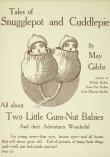 6791126089809856474.jpg
6791126089809856474.jpg
 6791126089809856474.jpg
6791126089809856474.jpg
'Snugglepot and Cuddlepie and two little gumnut brothers who set off on an adventure to see a human. They are joined on their quest by Mr Lizard and along the way, meet Little Ragged Blossom at a dance. Together the four adventurers meet many new bush friends and battle the evil Mrs Snake and the very scary Bad Banksia Men.' (Source: Author's website)
The alternative title Tales of Snugglepot and Cuddlepie : All about Two Little Gum-Nut Babies and their Wonderful Adventures is the title found on the [1918] dust jacket; the title Tales of Snugglepot and Cuddlepie is the title found on the cover; the title on the title page (and also the AustLit record) is Snugglepot and Cuddlepie : Their Adventures Wonderful.
This is a different work to Tales of Snugglepot and Cuddlepie illustrated by Noela Young in 1980.
 Teaching Classic Australian Children's Fiction
Anthony Shaw
,
St Lucia
:
AustLit: The Australian Literature Resource
,
2016-
15827758
2016
website
prose
Teaching Classic Australian Children's Fiction
Anthony Shaw
,
St Lucia
:
AustLit: The Australian Literature Resource
,
2016-
15827758
2016
website
prose
This Exhibition is a collection of extensive teaching resources for classic Australian children's texts. The resources are aimed at upper primary school and lower high school teachers. The collection forms part of Anthony Shaw's Learning with Literature program.
'The Children’s Book Council of Australia (CBCA) administers the oldest national prize for children’s literature in Australia. Each year, the CBCA confers “Book of the Year” awards to literature for young people in five categories: Older Readers, Younger Readers, Early Childhood, Picture Books and Information Books. In recent years the Picture Book category has emerged as a highly visible space within which the CBCA can contest discourses of cultural marginalization which construct Australian (‘colonial’) literature as inferior or adjunct to the major Anglophone literary traditions, and children’s literature as lesser than its adult counterpart. The CBCA has moved from asserting its authority by withholding judgment in the award’s early years towards asserting expertise via overtly politicized selections in the twenty-first century. Reading across the CBCA’s selections of picture books allows for insights into wider trends in Australian children’s literature and culture, and suggests a conscious engagement with social as well as literary values on the part of the CBCA in the twenty-first century.'
'This chapter explores some of the ways in which the literary arts of poetry and novels, especially those for children and young people, and the visual arts of paintings and posters, often depicting children, were used in Australia during the First World War to show and tell not only the idea of war to those at home, but the idea of home for those at war. It is part of wartime rhetoric to set personal identity and home place as core (as something worth fighting for), but simultaneously to indent that core with qualities and places beyond the personal and the personally experienced: thus not just my home, my
family, my community, but our family, our community, our nation. This concept of home becomes imbued with symbols that both represent and unite and that establish a semiotics of home that includes both abstractions – a deep inner sense of shared cause alongside like-minded companions, and the materiality of physical space. This physical space expands into the metaphysical, into not just images of home and place and landscape, but potent metonymous and synechdocal imageries of home and place and landscapes.'
Source: introduction.